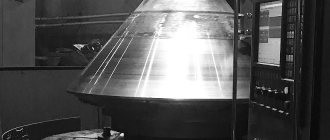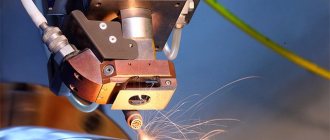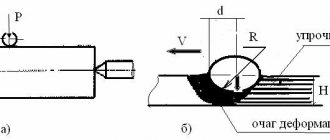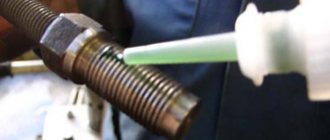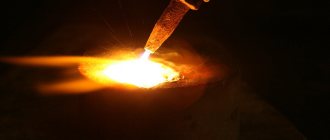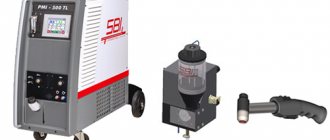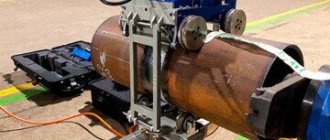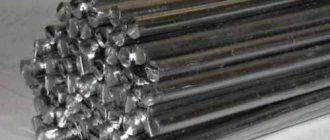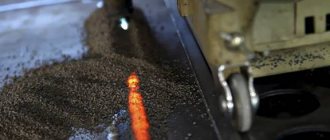Methods for tinning a car body
Repair work that involves straightening the car body is rarely done without special operations related to tinning metal parts.
Soldering a body with tin is a common procedure that requires skillful use of the technique of working with a soldering tool. During this process, molten solder is first applied to the parts to be joined and then, due to diffusion, fused with the metal of the workpiece. After hardening, reliable contact between the sheet body elements is established. One of the specific features of tinning operations is that the melting temperature of the solder is noticeably lower than the same indicator for the metals being joined.
Differences from welding
It is very difficult for an untrained person to see the difference between welding and soldering, because the connecting seam has practically no visual differences. Meanwhile, the principles of operation of these technologies are radically different. So, what is the difference between welding metal parts and soldering?
The main difference is the effect on the surface . When welding, the workpiece is exposed to an electric arc that occurs when a closed circuit is broken. Under the influence of high temperature, a melt zone is created in which the base metal and flux are mixed. When solidified, a weld seam is formed. When soldering, the connection zone consists exclusively of low-melting solder, without fractions of the main product. The melting point of consumables is not sufficient to change the state of aggregation of the workpieces.
To perform welding work, expensive equipment is required, which depends on the type of welding. In some cases, auxiliary devices are necessary, such as a feed mechanism for semi-automatic machines. The equipment for sealing is simple and low cost. This is the reason for the popularity of soldering when performing restoration repairs at home.
This is how welding differs from soldering. Despite a lot of advantages, the technology in question has not received proper distribution due to low peel strength . For reliable fastening, the parts are joined to the ceiling along a plane.
Purpose and benefits
Tinning of metal with tin is used in the following industries:
- Electronics and radio engineering. Tin protects circuit boards from corrosion.
- Aviation and mechanical engineering. Many structural elements of machine tools and aircraft are processed.
- Cable and wire. In addition to rubber insulation, tin protects metal conductors from the effects of sulfur, which is contained in rubber and plastic.
- Food. Almost all kitchen utensils related to cooking are protected using special food-grade tin, which does not pose a threat to human health. Also, containers intended for making canned food are coated with tin: this increases their shelf life - many conscripts remember Soviet stewed meat from the fifties, which until recently was in military warehouses as an emergency reserve.
Tin coating is used as a pre-treatment of bearings before they are filled with babbitt. Also, tinning is an integral part of the technological chain for making a gap-free connection, which is called a seam seam.
However, tinning technology has gained the greatest popularity as a means of preliminary preparation before soldering. This is due to the following reasons:
- Performance. Modern technologies make it possible to tinning a large number of elements in a short period of time - it is not without reason that it is actively used in mass production.
- Reliability. The chemical inertness of tin provides reliable protection against moisture, salts and organic acids.
- Durability of the coating. Tin and its alloys have high adhesion to any metal surface. The plastic layer is not destroyed by mechanical processing of the part.
- Heat resistance. Tinned coating can withstand significant temperature changes.
GOST 17325-79. Soldering and tinning: basic terms and definitions
This interstate standard establishes clear terms and definitions that should be used in technical documentation. It covers all areas of the technologies considered: from general concepts to connection defects.
The alphabetical index of terms has been translated into English and German.
The standard has valid status.
Tinning is a process considered to be a precursor to soldering. After processing, a thin layer of tin forms on the surface.
Areas of application
Different types of solders are in demand in different areas and differ in their physical properties and useful characteristics:
- The composition of POS-18 solder , in addition to tin and lead, contains elements such as sulfur, iron, aluminum, etc. The melt temperature of this mixture ranges from 180 to 285 degrees. The alloy is mainly used in liquid form, but it has some advantages: a reduced level of fragility, resistance to moisture. Disadvantages include the presence of lead and the lack of mass production of the substance. Areas of application: tinning of individual parts of car bodies, soldering of radio device elements, use in the repair of heating systems.
- The composition of POS-50 differs in the same percentage of lead and tin , but it also contains impurities of iron, copper, bismuth, zinc and even arsenic. The resulting metal has high fluidity, electrical conductivity and good heat-conducting properties, but is not suitable for manual soldering due to rapid crystallization. Solder of this type can be used to process seams in parts that require maximum tightness, for example, in low-power PC system units and measuring equipment.
- For the repair of household devices, the composition POS-30 , which is a soft alloy, has high hardness and a dark color, is more suitable. Its main advantage is the ability to solder small elements due to low resistance, and in some cases, to replace failed expensive parts. The composition is also used for tinning zinc sheets.
- POS-90 solder , which contains 90% tin and only 10% lead, is suitable for repairing medical equipment and restoring food utensils.
You can solder different metals using a tin alloy:
- If it is stainless steel containing chromium, nickel and titanium, then the type of solder will depend on the operating conditions. In a dry room, compositions with the addition of chromium and nickel are used; in high humidity they should contain silver with a minimum amount of nickel.
- To create jewelry from silver, soldering this metal with tin is allowed, but this must be done very carefully, using a thin soldering iron tip.
- As for nickel, it can also be soldered with tin solders when you need to obtain individual parts of devices and systems used in the chemical industry.
- For durable connections of cast iron products, including the installation of pipelines for various purposes, tin solder with the addition of brass or nickel is used.
- By using tin solder, you can repair a car's fuel tank if it is slightly damaged, and you do not need to pour water into it.
A special type of solder POSSu consists of tin, lead and antimony and has found application in the repair of refrigerators, car chains, and any products with a zinc coating.
Preparation of products
The cleaner the metal surface, the more firmly the solder will attach to it. Therefore, depending on the requirements for the workpiece itself, different methods of preparing metal for tinning are used.
The first method is to clean the metal surface with brushes. Typically, this tool removes scale and rust. First, the product is washed with water and then cleaned with a brush. Lime, sand, and pumice are often used at this stage.
The next way to prepare for tinning is to grind the metal with sandpaper and discs. This stage is the finalization of the product, that is, bringing its surface to maximum evenness.
Degreasing is used using sodium compounds: sodium hydroxide – 10-15%, sodium phosphate – 10-15%, sodium carbonate – 10-15% solution. Let us add that chemical solutions must be heated to 50-80C before use.
Etching is also used. For this, sulfuric acid is used.
Heating Methods
There are several ways to heat consumables. The following devices are most often used at home:
- Soldering iron . Used to perform work characterized by relatively low temperatures. The maximum impact does not exceed 400 Cº. Modern models are equipped with a mechanism for adjusting the temperature. They produce battery-powered soldering irons. Ideal for working with gold and other soft metals.
- Burner . There are gas and plasma models. They use one type of fuel - natural gas, and differ only in the size of the flame. They operate at high temperatures, which makes it possible to solder refractory metals. The disadvantage of burners is the difficulty of adjusting the flame temperature.
DIY patch on a car body soldered using solder and a soldering iron
The second option for installing a patch can be dated back to the era of Soviet car enthusiasts, when tinning of teapots and similar procedures that seemed quite mundane at first glance were in use. Automatic welding machines were rare back then, and not everyone had ordinary transformer welders, and holes formed with an unenviable frequency. So it was necessary to look for a way out, and it was found. Soldering metal using a powerful soldering iron and solder is what can eliminate holes in the body of a rotten car. As with soldering, here we will need soldering flux.
Its role is to create a protective film around the soldering area, which will prevent rapid oxidation, thereby improving the quality of the connection between the solder and the metal that we are soldering. Soldering acid is perfect for this. The latter can be purchased at radio stores. Now about the soldering iron. The power of a regular soldering iron, like 25-40 Watt soldering iron, is clearly not enough to heat the metal and solder. Here you need a soldering iron of 1 kW or so. You can use a soldering iron heated on a blowtorch or even a gas burner. It is better to take hard-melting solder; it will be somewhat more difficult to work with, but its durability will also be higher. We clean the holes from rust and dirt. and the edges to metal.
If the holes are small, then you can simply “tighten” them gradually with solder, from the edges to the center. First, solder is applied to the edges, and then builds up to the middle of the hole.
Next, clean and putty.
If the hole is large, then you can use a tin plate, for example from a canned food. The plate is soldered to the edges of the hole.
Then it is pressed a little inward and puttied.
Classification of brass alloys
Brass can be double or multi-component. In the first case, the composition includes only copper and zinc, which increases the hardness of the alloy. Other components that improve its physical and chemical characteristics include aluminum, iron, silicon, manganese, nickel, tin, lead and other elements. For this reason, it is necessary to know exactly the composition of brass in advance; this will help determine the method, as well as the specifics of soldering.
Brass is classified according to its chemical composition:
- Two-component (double, simple). It consists only of copper and zinc. The percentage of these components may vary. These compositions are marked with the letter “L” and a number, which always indicates the amount of copper. For example, L90 contains from 88 to 91% copper, zinc accounts for 8.8-12%. There are impurities, but their amount is minimal - about 0.2%.
- Multicomponent (special). This brass has a large number of ingredients that increase the corrosion resistance of the alloy, its strength, and hardness. It is marked differently: another one is added to the letter “L”, meaning the alloying element, and another number appears - the percentage of alloying metal. For example, LA77-2 is aluminum brass, it contains 77% copper, about 2% aluminum, and the rest is zinc. All such alloys are named after the alloying element: ferrous, silicon, nickel, manganese, lead, etc.
Fluxes
Its purpose is to protect the contact surface from oxide film. A high-quality flux should remove traces of rust before work, and also prevent the appearance of fresh traces of corrosion. They differ in the following parameters:
- Chemical activity.
- Heating temperature.
- Water content of the composition (aqueous/anhydrous).
- Release form (paste, gel, liquid).
The most popular fluxes are:
- Boric acid;
- Borax (sodium salt of boric acid);
- Rosin;
- Orthophosphoric acid;
- Zinc chloride.
If necessary, you can make your own soldering acid.
Peculiarities
A metal such as tin has been known to man since ancient times; its properties made it possible to use it for the manufacture of weapons and tools. Thanks to tin, bronze appeared, from which it became possible to create a variety of household items, as well as jewelry.
This element has many interesting characteristics, including:
- high degree of malleability, through pressure, due to good ductility and resistance to deformation;
- easy fusibility, melting point - 231.9 degrees, which makes it possible to make alloys with other metals;
- the density of the element is similar to that of iron;
- the metal is capable of boiling at significantly high temperatures and remains in liquid form for a long time;
- in a state of crystallization, tin has a silvery color with a characteristic metallic luster;
- also, products made from this chemically pure substance can transform into gray powder when exposed to low temperatures.
Of all the properties of tin, perhaps the most important is its density, since it allows the metal to be used to create various alloys.
It is no secret that tin is used for soldering all kinds of parts and microcircuits of radio-electronic devices , and it is, indeed, ideal for this because it melts well, but due to its high cost, the composition based on this substance is supplemented with various additives.
Soldering tin most often includes lead, but nickel, cadmium, silver, zinc, copper and antimony are also used. Additives are selected depending on the metal of the parts that must maintain integrity. Therefore, the substance is combined with elements that give a certain melting point.
In Russia, a particularly popular composition for solder is an alloy of tin and lead (POS) - these are soft alloys with melting at 300 degrees.
Solder tin is produced in the form of special paste, rods, balls and wire.
Tinning of welds and body metal
Topic author Vityok, 11/29/2004, 11:56
- 5 pages
- Log in to reply to this topic
#61 DEMON
- Users-2
- 2,417 messages
- 15
- Offline
- Card
- PM
Message added 11/18/2010, 10:24 pm
This is called “I have loved difficulties since childhood.” Anything, but not anticorrosive in hidden cavities!
Yeah, but the part will only be tinned on one side - the outer side. If you tin it on both sides, then you won’t be able to weld it properly. In the welding areas, tin will flow and bare iron will remain there - a source of future corrosion. If you put it on bolts, or whatever else was suggested here, then the metal at the fastening point is still deformed, removing the tin, and you still need to drill holes.
In general, no matter how you look at it, you’ll have to treat it against measles.
- ∧
- Full editing
- Quick Edit

